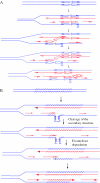Inverted repeat-stimulated sister-chromatid exchange events are RAD1-independent but reduced in a msh2 mutant
- PMID: 16166656
- PMCID: PMC1216339
- DOI: 10.1093/nar/gki835
Inverted repeat-stimulated sister-chromatid exchange events are RAD1-independent but reduced in a msh2 mutant
Abstract
Inverted repeats (IRs) and trinucleotide repeats (TNRs) that have the potential to form secondary structures in vivo are known to cause genome rearrangements. Expansions of TNRs in humans are associated with several neurological disorders. Both IRs and TNRs stimulate spontaneous unequal sister-chromatid exchange (SCE) in yeast. Secondary structure-associated SCE events occur via double-strand break repair. Here we show that the rate of spontaneous IR-stimulated unequal SCE events in yeast is significantly reduced in strains with mutations in the mismatch repair genes MSH2 or MSH3, but unaffected by a mutation in the nucleotide excision-repair gene RAD1. Non-IR-associated unequal SCE events are increased in both MMR- and rad1-mutant cells; however, SCE events for both IR- and non-IR-containing substrates occur at a higher level in the exo1 background. Our results suggest that spontaneous SCE occurs by a template switching mechanism. Like IRs, TNRs have been shown to generate double-strand breaks (DSBs) in yeast. TNR expansions in mice are MSH2-dependent. Since IR-mediated SCE events are reduced in msh2 cells, we propose that TNR expansion mutations arise when DSBs are repaired using the sister or the homolog as a template.
Figures


Similar articles
-
Effects of mutations in SGS1 and in genes functionally related to SGS1 on inverted repeat-stimulated spontaneous unequal sister-chromatid exchange in yeast.BMC Mol Biol. 2007 Dec 31;8:120. doi: 10.1186/1471-2199-8-120. BMC Mol Biol. 2007. PMID: 18166135 Free PMC article.
-
Both CAG repeats and inverted DNA repeats stimulate spontaneous unequal sister-chromatid exchange in Saccharomyces cerevisiae.Nucleic Acids Res. 2004 Oct 19;32(18):5677-84. doi: 10.1093/nar/gkh901. Print 2004. Nucleic Acids Res. 2004. PMID: 15494455 Free PMC article.
-
Multiple recombination pathways for sister chromatid exchange in Saccharomyces cerevisiae: role of RAD1 and the RAD52 epistasis group genes.Nucleic Acids Res. 2003 May 15;31(10):2576-85. doi: 10.1093/nar/gkg352. Nucleic Acids Res. 2003. PMID: 12736307 Free PMC article.
-
DNA repair and trinucleotide repeat instability.Front Biosci. 2003 May 1;8:s653-65. doi: 10.2741/1107. Front Biosci. 2003. PMID: 12700078 Review.
-
Trinucleotide repeat instability via DNA base excision repair.DNA Repair (Amst). 2020 Sep;93:102912. doi: 10.1016/j.dnarep.2020.102912. DNA Repair (Amst). 2020. PMID: 33087278 Free PMC article. Review.
Cited by
-
Structural parameters of palindromic repeats determine the specificity of nuclease attack of secondary structures.Nucleic Acids Res. 2021 Apr 19;49(7):3932-3947. doi: 10.1093/nar/gkab168. Nucleic Acids Res. 2021. PMID: 33772579 Free PMC article.
-
Spectrum of mitochondrial DNA deletions within the common deletion region induced by low levels of UVB irradiation of human keratinocytes in vitro.Gene. 2009 Jul 1;440(1-2):23-7. doi: 10.1016/j.gene.2009.03.019. Epub 2009 Apr 2. Gene. 2009. PMID: 19345726 Free PMC article.
-
Non-B DNA structure-induced genetic instability and evolution.Cell Mol Life Sci. 2010 Jan;67(1):43-62. doi: 10.1007/s00018-009-0131-2. Epub 2009 Sep 1. Cell Mol Life Sci. 2010. PMID: 19727556 Free PMC article. Review.
-
Properties of Mitotic and Meiotic Recombination in the Tandemly-Repeated CUP1 Gene Cluster in the Yeast Saccharomyces cerevisiae.Genetics. 2017 Jun;206(2):785-800. doi: 10.1534/genetics.117.201285. Epub 2017 Apr 4. Genetics. 2017. PMID: 28381587 Free PMC article.
-
Effects of mutations in SGS1 and in genes functionally related to SGS1 on inverted repeat-stimulated spontaneous unequal sister-chromatid exchange in yeast.BMC Mol Biol. 2007 Dec 31;8:120. doi: 10.1186/1471-2199-8-120. BMC Mol Biol. 2007. PMID: 18166135 Free PMC article.
References
-
- Ford M., Fried M. Large inverted duplications are associated with gene amplification. Cell. 1986;45:4425–4430. - PubMed
-
- Leach D.R.F. Long DNA palindromes, cruciform structures, genetic instability and secondary structure repair. Bioessays. 1994;16:893–900. - PubMed
-
- Lemoine F.J., Degtyareva N.P., Lobachev K., Petes T.D. Chromosomal translocations in yeast induced by low levels of DNA polymerase: a model for chromosome fragile sites. Cell. 2005;120:587–598. - PubMed
Publication types
MeSH terms
Substances
Grants and funding
LinkOut - more resources
Full Text Sources
Molecular Biology Databases
Research Materials

